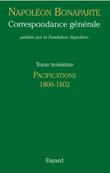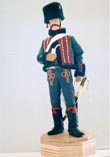| |
| |
EDITORIAL
What a splendid idea it was to have the night-time visits to museums organised throughout France last week.
No prizes for guessing that I went to that held at the Musée de l'Armée.
And what an excellent evening!
Three cheers for the directors of this establishment so beloved of Napoleonic visitors. They had it all: "culture", in the shape of the guided tours, "music", as in the concert given by the band of the French army and, the highpoint, the "son et lumière" arranged by Michel Albertini beneath the Dome, with its profusion of ideas and yet respect for this national burial site. The Emperor's Tomb, and those of Turenne, Foch, Lyautey, Joseph and Jérôme Bonaparte, illuminated and accompanied one by one, were given (if possible) even more majesty.
Between 10,000 to 15,000 people visited the Hôtel national des Invalides that night. And all came away with the same reaction: bravo!
Thierry Lentz

|
|
|
| |
THIS MONTH'S BOOK
NAPOLEON I, Correspondance générale de Napoléon Volume III: «Les Pacifications», 1800-1802
This third volume of the Correspondance générale de Napoléon (in French) published by the Fondation Napoléon with Editions Fayard contains 2,567 letters written during the period from 1800 to 1802, 700 of which are thought not to have been previously published. Whilst the previous periods were dogged by possibly forgeries, from 1800 on, the Correspondence stands on surer ground. Napoleon was at that time assisted by several secretaries and his writings were less personal. Indeed, it was political questions which occupied Napoleon Bonaparte, for at that time he was head of state. 1800-1802 is an important period: this is the time for «pacification», for the reconstruction of France as it found its way out of the Revolution. © Fayard

|
|
|
| |
NAPOLEON'S ARMY, 1:7 SCALE
As a history enthusiast and model maker, Bernard Pacaud has become a specialist in 1:7 scale figurines. And he has honed this skill after many years of practice and historical research, marrying a taste for the minutiae and an extraordinary effort to create realism. And the result is a series of soldiers from Napoleon's army, including a figurine of the emperor himself at the Battle of Austerlitz.
Canonnier à cheval de la garde (Mounted gunner of the guard) (1805)
© Bernard Pacaud

|
|
|
| |
200 YEARS AGO
30 May, 1806, a decree followed Napoleon's decision to create an assembly of Jewish notables in France
«According to a report which I have received, certain Jews in several northern départements, whose only profession is that of money-lender, have, by the accumulation of the most immoderate interest, put many farmers in these lands in the greatest financial straits. […] On 15 July, in our fair town of Paris, an assembly of individuals professing the Jewish religion and living in France shall be formed.» «The members of this assembly shall number [111], taken from the stated départements and selected by the Prefects from amongst Rabbis, householders and other Jews distinguished by their probity and enlightenment.»
(Correspondance n°10291)
Despite being concerned by Jewish issues in France right at the beginning of his reign, Napoleon did not pass legislation until 1806, when he was faced with mounting hostility to Jews in France and the growing indebtedness of landowners, notably those in Alsace. He reformed the rules governing loans or usury, a business largely practised at this time by Jews. At the same time, Napoleon decided to creat a council of Jewish notables which would represent Jews throughout the Empire, so as to be able to consult with them on how to associate them with his policies. The Council met five times between July and September, 1806. As a result of these meetings, Napoleon decided to summon a Grand Sanhedrin, as a modern version of the council which in ancient times met in Jerusalem. The Grand Sanhedrin met several times up until 9 March, 1807, and decided upon certain pieces of legislation reorganising Jewish worship and making Jews full French citizens. In many ways, this was the continuation of the Concordat of 1801 and the Code civil of 1804.
150 YEARS AGO
The end of May and the beginning of June 1856 in France was marked by sudden, exceedingly high water levels in French rivers. The high-water-mark for 1856 is still today considered as exceptional. Already on 29 May local authorities were beginning to be concerned: «The river Allier is very full and threatening to break its banks. At Pont l'Allier, the levels have reached 3m23. And the water is rising at an average speed of 6 centimètres per hour» (Telegram from Moulins, 7am); «The Loire is rising. The water have reached 2m49» (Nevers, 10am). The newspapers reported the same thing: «The rain which has been falling with interuption for the past 48 hours is threatening us with a new flood. Already this morning the Garonne was exceedingly full, and its yellowish, muddy waters have started to bring with them tree branches, roots and debris of all sorts. At 9-30am, the Garonne-meter was reading 4m50 above its lowest level. » (L'Aigle de Toulouse, 29 May, 1856).
Nor was there any respite in the following days, the Loire reaching 3m98 in the morning of 31 May and 5m75 at 4pm on the same day. The resulting damage was considerable: churches, bridges and houses destroyed, roads and cattle washed away, railway line uprooted, and cemeteries ruined.
Wishing you an excellent, Napoleonic, week.
Peter Hicks
Historian and Web editor
THE NAPOLEON.ORG BULLETIN, No 373, 26 May - 1 June, 2006
Interested in the work of the Fondation Napoléon? Why not participate, either generally or in a specific project, by making a donation.
© this Napoleon.org weekly bulletin is published by the Fondation Napoléon. Reproduction or all or part of this bulletin is forbidden, without prior agreement of the Fondation Napoléon.

|
|
|
|
|
|
|
|
|
|
|
|
THIS WEEK in the MAGAZINE
WHAT'S ON
Talks:
- Sergio Valzania and Alessandro Barbero, The sun of Austerlitz and the rain of Waterloo, Mezzago, (near Milan), Italy
- John A. Davis, Naples, Napoleon and Europe, Naples, Italy
Commemorations:
- Commemoration of the 147th anniversary of the “BATTLE OF MAGENTA”, Magenta, Italy
- Wreath laying ceremony, Rivoli Veronese, Italy
- Plancenoit 2006: 8th Napoleonic Bivouac, Plancenoit, Belgium
- Pultusk 2006, Pultusk, Poland
- Jena 1806-2006 - Rendezvous in Thuringia The "Journées de Thuringe 2006" and the bicentenary of the Battle of Jena/Auerstädt
Exhibitions:
- Napoleon on the Nile: Soldiers, Artists, and the Rediscovery of Egypt, New York, USA
- Géricault, a world of madness, Lyons, France
- Il tempo dell'Imperatore: gli orologi restaurati delle residenze di Napoleoni all'Elba
- Treasures of the Fondation, Mexico 2006, Monterrey, Mexico
- "Battle in a sittingroom." The Austerlitz wallpaper, Museo Napoleonico, Rome, Italy
- "Beauty celebrating power": Vincenzo Monti in the Napoleonic period, Milan, Italy
- Louis Napoleon: at the court of the first King of Holland, 1806-1810, Apeldoorn, Netherlands
Got a problem with the letter? Try the home page: http://www.napoleon.org
<<
|
|


